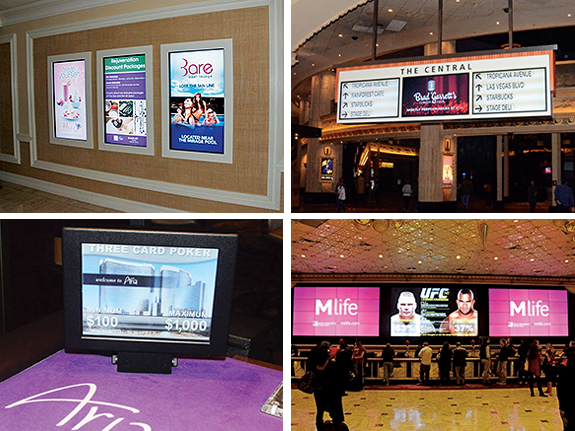Digital Signage: Reducing total cost of network ownership
by all | 18 February 2015 10:12 am
 [1]
[1]Photos courtesy MGM Resorts International
By Randy Dearborn
Typically, when someone thinks about reducing costs within a business or operation, the first options that come to mind are reducing capital costs or cutting back on labour. While these actions may initially bear some savings, they can also lead to unforeseen negative issues, along with deferring unexpected costs down the road. It is important to thoroughly take into account the effects of cost-cutting, especially when considering enacting draconian measures.
Rather than specify an arbitrary percentage of a budget to cut and then ‘back into’ that number by finding the easiest, quickest components of the business to eliminate—while spouting platitudes like “Everything seems to be working fine, so we can cancel all of our service agreements” or “Let’s cut our staff and hours of operation, since the remaining staff can simply work harder”—the best approach is to ask, “What is this business trying to achieve and how can it best use its existing tools to realize those goals?”
This approach can be applied to how businesses design, create, implement and maintain digital signage content, software and hardware for networks of any size. Indeed, a full understanding of the entire process behind digital signage provides an immense advantage when it becomes necessary to scale back costs, as it is then possible to weight out the pros and cons relating to various sub-disciplines. The following are examples of strategies for such portions of the digital signage process.
Content creation
While the technical aspects of creating digital signage content may be fairly straightforward today, the greatest hurdle for many networks is synchronizing all of the media players across a large-scale system. It is particularly challenging when there are last-minute requests for new spots or changes to existing ones.
The best way to minimize this challenge and its associated costs is through continuous communication and a strong organizational structure. It will help, for example, to funnel as many requests as possible through one central contact person, such as a marketing professional, who can focus on ‘herding the cats’ to ensure simplicity of deployment for content from many sources.
This designated point of contact will need to be proactive in meeting with the different departments within the organization, compiling a master calendar of events and clarifying specifically which venues require which content. Another way to streamline the ‘content shuffle’ is to track all events that occur annually or at least semi-regularly. And if the content’s call to action is phrased in a generic manner, it will help reduce the number of last-minute change requests.
A casino, for example, might create several spots at once for recurring entertainers with the tag lines “Tonight,” “This weekend” and “Next week” and have them all loaded onto media players, so they are ready to be called up at any time.
Social media
Another quick win for content is to tap into social media, such as Twitter and Instagram. Indeed, screen zones dedicated to these sources now reside on many networks.
A generic, property-specific background can be created for each and then updated with seasonal themes, such as Valentine’s Day or Halloween. Time-sensitive specials and offers can be posted through Twitter handles associated with the network or even the specific screen. This is a quick, easy and inexpensive way to push out marketing campaigns to a digital out-of-home (DOOH) advertising network, even at the last minute.
Hardware
For many organizations, hardware is much easier to tackle than content because it already tends to rely on one department—e.g. information technology (IT) or audiovisual (AV)—and not on others. As long as the venue has power and a local data network, whether wired or wireless-fidelity (Wi-Fi), and bandwidth constraints are not an issue, then the hardware is generally ‘good to go.’
The department in charge of hardware should establish a corporate-standard spreadsheet with a pricing matrix for all of the different digital signage formats, including different screen sizes and narrow-bezel options for various video wall configurations. Requirements for touch and non-touch screens should also be clearly marked out in the grid.
It may be advisable to source screens from different manufacturers for different purposes, e.g. marketing content versus broadcast content, particularly if some screens will be operated for fewer hours per day than others or if some will need to decrypt content with strong digital rights management (DRM). By minimizing the number of manufacturers in line with a minimal number of screen purposes, however, the organization can benefit from leveraging long-term pricing and keeping far fewer ‘spares’ on its shelf, knowing its digital signs can be easily replaced from the same product line, in various sizes. And with regard to saving on costs, most screens are seeing prices drop continually.
 [2]
[2]Whichever department is in charge of hardware should establish a pricing matrix for all different formats, including touch screens.
The pricing matrix should also list the current costs of media players, brackets, cables and software licences associated with each screen. This way, anyone looking at the spreadsheet can easily grasp the cost of each digital signage deployment within the network and will feel more comfortable with project pricing methods. It can also be a good idea to send out an older pricing list and follow up with a newer, updated one, so everyone in the organization can see how costs have dropped!
Further savings from screen vendors can be achieved by being open to purchasing discounted end-of-life models. Many ‘unbudgeted’ custom digital signage installations can be justified this way over the years.
Indeed, it is a good idea to keep an ongoing list of projects that have not received funding yet or have been put aside in favour of other projects. Then, if the department sees major value in new hardware procurement, it can pull out the pricing matrix and show the financing group the potential for savings. More often than not, this method will get the new project approved.
Software
Reducing software costs tends to be more of a challenge than reducing hardware costs, unless the organization is starting up a new digital signage infrastructure from scratch. Some companies, however, have benefited in terms of costs by developing their own software in-house, right down to writing the code; this can certainly be used as leverage when negotiating with dedicated digital signage software development companies.
Another negotiating tactic is to request tiered pricing for software for different types of applications. Software should not cost the same, after all, for a simple meeting room door screen as for a complex, interactive kiosk. The vendor must clearly define how pricing can be adapted to such variances in inventory. In an ‘enterprise’ software deal for a large-scale digital signage network, especially, there is always room for negotiation.
Third-party advertising
Another cost benefit can come from revenue streams through third-party advertising. This option is not viable for every digital signage network, but it should be considered. If an external advertiser will buy a portion of the screen time and, in turn, the organization can sell that advertiser’s products or services, then it is a win-win proposition. And the additional revenue can be targeted toward expanding the digital signage network, which will then yield even more opportunities for third-party advertisers.
The overview
When addressing ways to reduce the total cost of ownership (TCO) for a digital signage network, it is important to be flexible and creative and, most of all,
to understand the organization’s goals. There is no point in focusing in on minutiae before stepping back and looking at the entire system. With fresh eyes, the network can be examined from all operational viewpoints and in all of its aspects.
Randy Dearborn is vice-president (VP) of multimedia and guest technology for MGM Resorts International and incoming 2015 vice-chair for the Digital Signage Federation (DSF). He also serves on the Digital Signage Expo (DSE) advisory board. This article is based on a seminar he is scheduled to present at the 2015 DSE in March in Las Vegas, Nev. For more information, visit www.mgmresorts.com and www.digitalsignagefederation.org; and for details about his presentation and other educational seminar, visit www.dse2015.com.
- [Image]: http://www.signmedia.ca/wp-content/uploads/2015/02/crop1.jpg
- [Image]: http://www.signmedia.ca/wp-content/uploads/2015/02/Image-002.001.png
Source URL: https://www.signmedia.ca/digital-signage-reducing-total-cost-of-network-ownership/